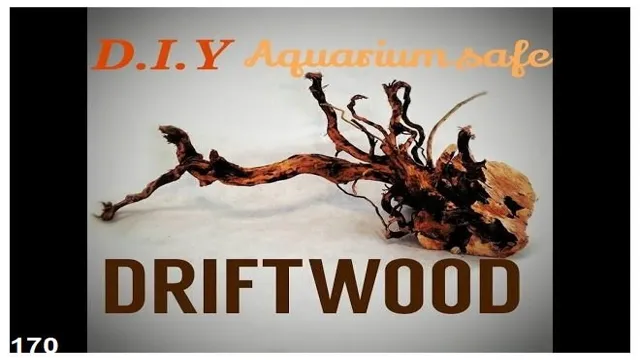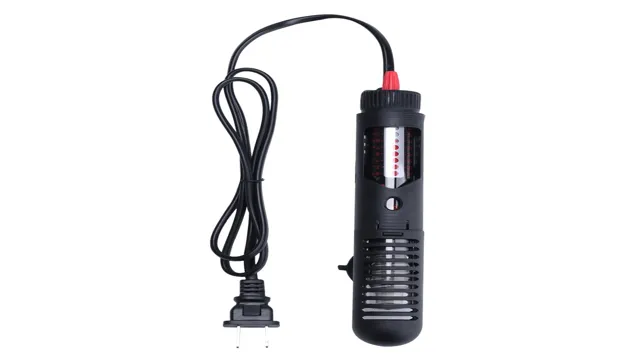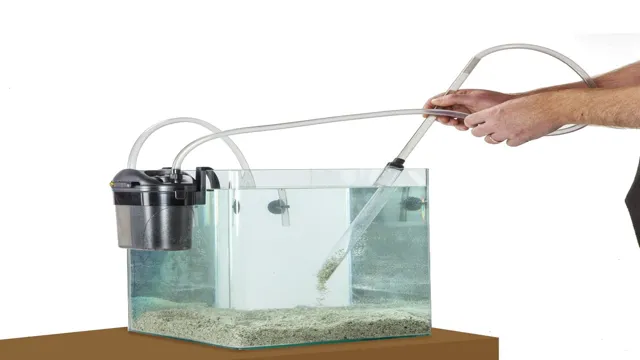How to Know if Driftwood is Safe for Aquarium: Tips and Guidelines

Driftwood can be an attractive addition to any aquarium, adding a natural and rustic feel to the underwater kingdom. However, many aquarium owners are often left wondering whether their driftwood is safe for their fishy friends. While driftwood can be a great addition to your aquarium, it’s important to ensure that it’s safe for your aquatic inhabitants.
Worry not, because we’re here to answer the question: Is Your Driftwood Safe for Aquarium? In this blog post, we’ll dive into the details about what makes driftwood safe or unsafe for your aquarium, and what factors you should consider before making a purchase. So, before you make any decisions, let’s explore the world of driftwood and aquarium safety together!
Why Safety is Important?
Driftwood is a popular addition to aquariums as it not only provides a natural look but also serves as a hiding spot and a source of food for some aquatic creatures. However, it is crucial to make sure that the driftwood used in the aquarium is safe for the fish and other aquatic inhabitants. So, how to know if driftwood is safe for aquarium? The key is to choose driftwood that has been cured and prepared correctly.
Unprocessed driftwood may contain harmful compounds that can harm aquatic animals, so it’s crucial to source driftwood from reputable suppliers. It’s also essential to clean and sanitize driftwood before adding it to the tank as it may have harmful bacteria or parasites. Another thing to keep in mind is the type of wood used as some species may release toxins.
By taking these precautions, you can ensure that the driftwood in your aquarium is safe and won’t pose any risk to the aquatic life.
Beneficial Properties of Driftwood in Aquariums
Safety When adding driftwood to your aquarium, it is important to consider safety as a top priority. Not all types of wood are suitable for aquariums, as some may contain harmful chemicals or release toxins into the water. Make sure to thoroughly research the type of wood you plan on using and only purchase from reputable sources.
It is also important to properly prepare the driftwood before adding it to your aquarium, which includes soaking it in water for an extended period to remove any possible contaminants. Neglecting safety precautions can result in harm to your aquatic pets or even worse, death. So always remember to prioritize safety when incorporating driftwood in your aquarium setup.

Risks of Using Unsafe Driftwood in Aquariums
Keeping your aquatic pets safe should always be a top priority, and that goes beyond basic care like feeding and cleaning their tank. One potential danger that may not initially come to mind is the use of unsafe driftwood in aquariums. While driftwood can add a natural and visually pleasing element to your tank, using wood that hasn’t been properly prepared or adheres to safety standards can put your fish at risk.
Unsafe driftwood can leach harmful chemicals into the water, alter the pH balance of the tank, or even harbor harmful bacteria. Always be sure to source driftwood from reputable dealers, and thoroughly clean and prepare it for use before adding it to your aquarium. Taking these precautions can help keep your aquatic pets safe and healthy in the long run.
How to Identify Safe Driftwood?
When it comes to adding driftwood to your aquarium, it’s essential to ensure that it’s safe for your aquatic creatures. While taking a stroll along the beach or riverbank, you might come across different types of driftwood, but not all are suitable for an aquarium. So how can you identify safe driftwood for your tank? First, avoid picking up any driftwood that has a foul smell or signs of rot.
Secondly, avoid driftwood that has cracks or sharp edges, as they can harm your fish or damage the aquarium. Additionally, ensure that the driftwood has been properly dried and cured to prevent the leaching of toxins. Finally, perform a vinegar test by pouring vinegar over the driftwood and observing for any fizzing, which would indicate the presence of alkaline substances, harmful to your aquatic animals.
By following these tips, you can select safe driftwood that would add to the functionality and aesthetics of your aquarium while keeping your pets safe.
Visual Identification Techniques
If you enjoy beachcombing for driftwood, it’s important to know how to identify safe driftwood. One visual identification technique is to look for wood that is weathered, with a natural patina and texture, which indicates it has been in the water or on the beach for some time. Avoid driftwood that looks freshly cut or has a smooth finish, as this may indicate it has been treated with harmful chemicals.
Another technique is to smell the wood – if it has a strong chemical odor, it is best to steer clear. To ensure the driftwood is safe for use in crafts or home decor, it’s also important to clean and sanitize it thoroughly before use. By following these tips, you can enjoy collecting and using driftwood while also protecting your health and the environment.
Smell Test for Driftwood
Driftwood is a popular addition to aquariums and terrariums as it provides a natural and rustic look. However, it’s important to make sure that any driftwood added to your aquarium or terrarium is safe for your pets. One way to identify safe driftwood is to conduct a “smell test.
” Safe driftwood should have a mild, earthy smell. If the wood smells like chemicals or has a strong, overpowering odor, it is likely not safe for your pets. Additionally, it’s important to avoid any driftwood that looks soft or decaying, as it can be a breeding ground for harmful bacteria.
Keep your pets safe and healthy by taking the necessary precautions when selecting and adding driftwood to their habitats.
Boiling or Baking Driftwood for Safety
Driftwood is a common natural resource that finds its way to the shores of rivers, lakes, and oceans. However, not all driftwood is safe to use for various crafts or as fuel for campfires. Therefore, it is essential to identify the safe driftwood that is free of toxins and any waterborne pathogens.
The best way to ensure that the driftwood is safe is by boiling or baking it before using it. Boiling driftwood will remove any harmful substances, such as tannins that can cause discoloration in the water and harmful bacteria that can make you sick. Baking driftwood is also an option, where you heat it in an oven at a temperature of at least 200 degrees for several hours, which will also help remove any harmful substances.
Identifying safe driftwood will go a long way in ensuring that you safeguard your health and avoid causing harm to the environment. Therefore, before using any driftwood for your intended purpose, always ensure that it is safe to use by boiling or baking it.
Where to Get Safe Driftwood?
If you’re looking for driftwood that is safe for your aquarium, there are a few things you need to keep in mind. First of all, never use wood that you find in nature, as it could carry harmful bacteria or parasites that could harm your fish. Instead, look for driftwood that is specifically sold for aquarium use.
These pieces of wood have been processed and treated to remove any harmful substances. When shopping for driftwood, make sure to inspect it carefully for any signs of decay or damage, as this can also pose a risk to your fish. Additionally, be aware that some types of wood may lower the pH levels in your aquarium, so it’s important to research the type of wood you’re considering before making a purchase.
By taking these precautions, you can find a beautiful piece of driftwood that is both safe for your fish and adds a natural touch to your aquarium.
Pet Stores vs. Online Vendors
When it comes to getting safe driftwood for your aquarium, you may be wondering if you should buy it from a pet store or an online vendor. Both options have their pros and cons, so it’s important to consider your needs and preferences before making a decision. Pet stores can be convenient if you want to physically inspect the driftwood before purchasing it.
However, they may have a limited selection and higher prices. Online vendors, on the other hand, offer a wider variety of driftwood at potentially lower prices, but you’ll have to rely on pictures and descriptions to evaluate the quality. Regardless of where you choose to buy your driftwood, make sure it’s safe for your aquarium by thoroughly cleaning and soaking it beforehand.
Additionally, consider using a quarantine tank to prevent any potential contaminants from entering your main aquarium. By being mindful of these precautions, you can enjoy a beautiful and healthy aquarium with safe and aesthetically pleasing driftwood.
The Importance of Researching Vendors
When it comes to decorating aquariums or terrariums, driftwood is a popular choice. However, not all driftwood is safe for your pets. It’s crucial to research vendors and ensure they are selling safe driftwood.
Avoid driftwood that has been obtained from lakes, rivers, or oceans, as they may contain parasites, bacteria, or toxins harmful to your pets. Instead, look for vendors that offer driftwood harvested from sustainably managed forests. These vendors can guarantee the driftwood’s safety since they take several measures to ensure it’s free from contaminants.
Additionally, avoid using any driftwood that has been treated with chemicals or has a strong odor, as it could be a sign that it’s not safe for pets. Overall, always take the time to research and choose reputable vendors to ensure your pets’ safety.
Conclusion
At the end of the day, the key to knowing if driftwood is safe for your aquarium is to do your research and trust your instincts. Don’t be fooled by flashy pieces that might be hiding harmful substances or organisms. Instead, take your time to inspect each piece thoroughly, check its history and source, and proceed with caution.
Remember, there’s no such thing as being too careful when it comes to the wellbeing of your aquatic friends. So ask around, do your due diligence, and as always, err on the side of safety. Happy driftwood hunting!
FAQs
What are the risks of using unsafe driftwood in aquariums?
Using unsafe driftwood in aquariums can release harmful chemicals or toxins into the water, possibly leading to illness or death in aquatic animals.
How can I tell if driftwood is safe for aquarium use?
Safe driftwood usually sinks in water, has a neutral odor, and has been properly treated or cured to remove any harmful substances. You can also research the specific type of wood to confirm it is safe for aquarium use.
Can I collect my own driftwood for aquarium use?
Yes, but it is important to properly clean and treat the driftwood before adding it to the aquarium. This includes boiling or soaking the wood to remove any bacteria or toxins.
Are there any types of driftwood that are never safe for aquarium use?
Yes, some types of driftwood can release harmful substances such as tannins or sap into the water. This includes cedar, redwood, and other types of softwood.
How often should I replace driftwood in my aquarium?
Driftwood can last for years if properly cared for and maintained. However, if you notice any signs of decay or discoloration, it may be time to replace it.
Can driftwood affect the pH balance of my aquarium?
Yes, some types of driftwood can release tannins into the water which can lower the pH level. This is especially common in newly added driftwood, but can be addressed through water changes or the use of products designed to raise pH levels.
Can driftwood be used in all types of aquariums?
Yes, driftwood can be used in freshwater and saltwater aquariums, as well as in planted tanks and aquatic terrariums. However, it is important to research the specific needs of your aquatic environment to ensure safe and appropriate use of driftwood.






